Every January for over 20 years I have spent 3 days in Southwold (a charming seaside town in East Anglia) tasting my way through hundreds of newly bottled Bordeaux wines. The “Southwold Group” was actually founded over 30 years ago by a group of wine merchants who wanted to comprehensively taste every single major Bordeaux Château wine produced in the most recently released vintage. The wines are always tasted strictly blind in peer-group flights of 12. This year it was the turn of 2008.
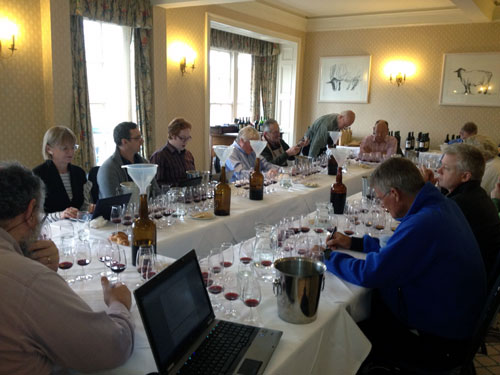
The tasting panel in full swing
|
The samples are laboriously assembled by British ex–pat negociant Bill Blatch from the cellars of each Château and shipped direct from Bordeaux to Southwold by Farr Vintners. The 600 or so bottles (we have 2 from each producer in order to have “back-ups") are then sorted out into their respective flights and tasted, discussed and scored by a panel of 16 hugely experienced tasters. As well as the buyers for most of the UK’s leading fine merchants (there are no fewer than 6 Masters of Wine) we are also joined by wine writers Steven Spurrier (of Decanter Magazine), Jancis Robinson MW (jancisrobinson.com and the FT) and Neal Martin (of The Wine Advocate).
This year we started, as always, with Saint Emilion – mainly because there are so many of them! Nearly 70 Châteaux to get through. They were divided into flights of twelve based on their approximate value and reputation. In the first flight there was a surprise, or maybe there wasn’t really, as Château d’Aiguilhe (a ringer from over the border in the Côtes de Castillon) came in first with good efforts from Tertre Daugay (the St Emilion recently purchased by Château Haut Brion) and La Tour Figeac.
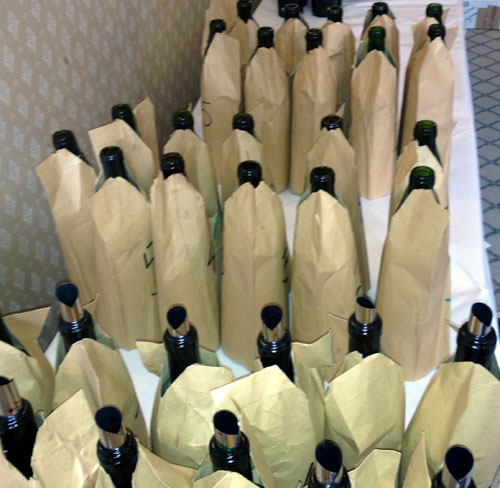
Samples bagged up and ready to be blind tasted
|
The next flight was more controversial with some of the more “modern” style wines - big, over-extracted fruit bombs like Les Asteries and Clos Saint Martin - scoring badly. My own favourite here was La Dominique, which combined a dark colour and obvious power with some class and a genuine sense of terroir.
Next up were some mid-priced wines. I absolutely hated the ghastly Australian Shiraz taste-alike that was served up as wine #6 (it turned out to be Péby Faugères), but my run-away winner was the beautifully silky and polished Château l’Arrosée which was a real stand-out. Good efforts from Trottevieille and Bellevue too.
On to the bigger names with the penultimate flight. A lot of very sexy, opulent, black-coloured wines here with Canon La Gaffelière, La Gomerie and Beauséjour Bécot all showing well.
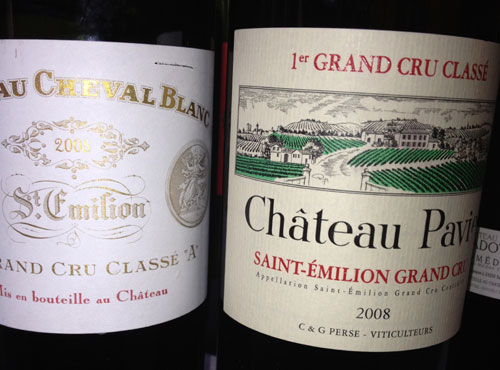
Two big names in St Emilion
|
Then on to the really big names of Saint Emilion. Yet again our old friend Le Tertre Roteboeuf showed magnificently. What a stylish and sophisticated wine this is with something about it that is different from all the others. This was a clear winner for me (and indeed the favourite of the group) with Angélus and Clos Fourtet also showing well. The more "modern" wines stood out like a sore thumb – everyone spotted Pavie a mile off – and of the wines in this style my favourite was definitely Valandraud. Cheval Blanc was lovely but not profound and Ausone rather closed.
We moved just over the border to Pomerol. The winner here was a sumptuously sexy, silky and drop-dead-gorgeous Le Pin but Pétrus and Eglise Clinet (as per usual) were outstanding and gave it a good run for its money. These two were just ahead of VCC, L’Evangile and La Conseillante which were all excellent too. 2008 seems like a particularly good vintage for Pomerol to me. Merlot doesn’t really like super-hot years like 2003 so I think that the relative coolness of this vintage was ideal in this appellation. By the way, we snuck Roc de Cambes (an old Farr Vintners favourite) in with the Pomerols and it did very well to beat a dozen of them.
We crossed the river and started with the Médocs and Haut Médocs. Some of these wines were rather lean – 2008 is not the most opulent of vintages and the three wines that dominated the scoring were produced by wine-makers known more for their exploits at more famous properties. Branas Grand Poujeaux (Stephane Derenoncourt), La Tour Carnet (Magrez/Rolland) and La Goulée (Jean-Guillaume Prats of Cos d’Estournel) had so much more flesh than the others in the flight and these fought it out for first place.

Mouton 2008 Artists Label
|
Then it was off to Saint Estèphe. This commune makes an ideal flight as there are exactly a dozen well-known wines. Nevertheless, the three big names always dominate and yet again (despite the wines being served in completely random order) it was no surprise that Calon Ségur, Cos d’Estournel and Montrose were the top three. I had Cos and Calon in a tie for first place which must be considered a moral victory for Calon considering the more modest price – their 2008 is a much richer and more concentrated wine than those we have tasted here in recent years. A new wine-maker I seem to remember. Cos d'Estournel was re-assuringly excellent whilst poor old next-door neighbour Cos Labory trailed in last as it so frequently does.
The Pauillacs were divided into 2 flights. Starting at the top, the First Growths were all magnificent. Lafite was stunning and was the overall winner. Latour was closed but broodingly powerful and Mouton absolutely gorgeous – it may be infanticide, but you could almost drink this now. The battle for top second growth is always a fascinating one. This year there was one clear winner – a wine of very nearly First Growth quality – the sensational Pichon Baron. This is a Château that just seems to get better and better to me and has performed brilliantly in many recent blind tastings. Léoville Lascases, and even the First Growths themselves, should watch out. A truly fantastic Pauillac . Another brilliant performer in recent years is Pontet Canet which came in just behind the Baron and just ahead of an impressive Forts de Latour. Of the lower-priced wines I was particularly impressed by Pichon Baron’s second wine, Les Tourelles de Longueville, which I actually scored higher than all but the very top Châteaux’s first wines. A fantastic performance for a moderately priced second label. No prizes for guessing last place, another dismal performance from Croizet Bages yet again. Oh dear.
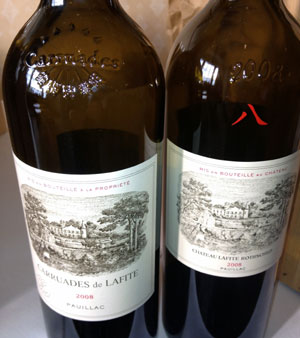
Lafite and "Baby Lafite"
|
There were plenty of top performers in Saint Julien, as usual. This year it was Léoville Poyferré and Léoville Barton battling it out for top spot with Ducru and Lascases both behaving like awkward adolescents. Good efforts too from the modestly priced Gloria and Lagrange and another outstanding showing for the much improved Saint Pierre – a wine that has come from nowhere to be challenging the super-seconds in the last few vintages.
In Margaux there was the usual number one spot for Château Margaux itself (of course) but joining the perennial challengers Palmer and Rauzan Ségla (both excellent again) this year was Issan which combined class and power. Impressive too for their power were Malescot and Lascombes but both too "tarty" to be typical Margauxs.
We concluded the tasting in Pessac-Léognan (or the Graves as most of us old folk still call it). You already guessed it, didn’t you? Haut Brion was a comfortable winner with Haut Bailly pressing La Mission for second place. I loved Domaine de Chavalier too (more powerful than usual) and the sexy, creamy, supple, silky charms of Smith Haut Lafitte.
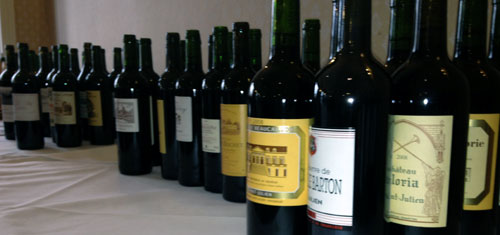
2008 Bordeaux samples
|
The overall conclusion of this tasting is that 2008 is a good, decent vintage but not a great one. It’s not nearly as good as Robert Parker's initial ratings (but he has already backtracked on those), but it has turned out a little bit better than I first judged it myself. It’s not Premier League like 2010, 2009, 2005, 2003 (in the N Médoc) or 2000 but it’s top of the Championship. It may turn out to be as good as 1996 – a vintage with which it shares a firm structure and tannic grip. It’s a less fleshy version of 2001 and perhaps a touch better than 2002, 2004 and 2006. For me 2007 is much more fun to drink now – and will remain so for the next 5 years or so. But, when the 2007’s start to become a little tired then 2008 should come into it’s own. It’s a vintage that will always be in the shadows of the 2 truly great vintages that followed it. If 2009 is the new 1959 and 2010 is the new 1961 then maybe 2008 is the new 1962.